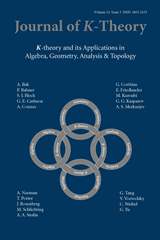Article contents
Homology of some Artin and twisted Artin Groups
Published online by Cambridge University Press: 21 September 2009
Abstract
We begin the paper with a simple formula for the second integral homology of a range of Artin groups. The formula is derived from a polytopal classifying space. We then introduce the notion of a twisted Artin group and obtain polytopal classifying spaces for a range of such groups. We demonstrate that these explicitly constructed spaces can be implemented on a computer and used in homological calculations.
- Type
- Research Article
- Information
- Copyright
- Copyright © ISOPP 2009
References
- 2
- Cited by




